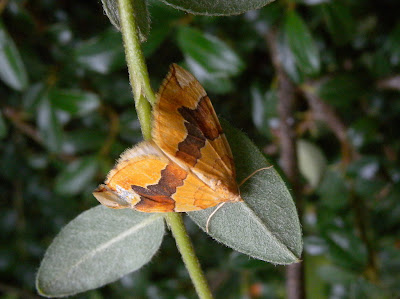When I arrived back at the house on Sunday morning, one look at Graham told me all I needed to know. The moths had arrived! The moths and us were then joined by a few of the neighbours, ending up with seven of us sat around the table emptying the traps and perusing the contents.
There were so many highlights, Poplar Hawk-moth, Burnished Brass, Garden Tiger, Buff-tip, Plain Golden Y, Phoenix and Buff Arches were among the crowds favourites. I have chosen to show a few of the moths that have not appeared on the blog before, starting with this Yellow-tail - shown here in it's typical (yellow) tail raised posture.
 |
| Yellow-tail |
We had several brand new species for the area. Two of these are species with very similar names, the Barred Red and Barred Yellow. Whilst these are both Geometrids, they are in different groups and looking at the pictures below you can tell this. The Barred Red also has a green form, to further confuse matters!
 |
| Barred Red |
 |
| Barred Yellow |
There were a lot of micro moths, which caused some identification headaches. Armed with our magnifying glasses however, we were able to resolve most of the conundrums and appreciate the beauty of some of our smaller moths. A real favourite with the group was the Bird-cherry Ermine. Although this looks very distinctive, there are actually eight superficially similar Yponomeuta species and great care is needed for correct identification. Up close though, the Bird-cherry Ermine can be told by the large numbers of black spots on the otherwise white wings.
 |
| Bird-cherry Ermine |
Another of the new species was one we almost let slip away. A cursory glance as it came out of the trap led me to identify it as a 'pale' Dark Arches. Graham then had a 'hang on a minute!' moment as he released the moths. With reference to the book my mistake was uncovered, as this proved to be a Grey Arches!
 |
| Grey Arches |
By any measure it was a successful session. We recorded 141 individual moths of 67 species. Several of them were new for us, and many of them enthralled the assembled crowd. When we dreamt up the surveys this is just what we wanted, to see lots of moths and to meet and enthuse people in the community about moths and other wildlife. As the photo shows, this is just what we got.

No comments:
Post a Comment